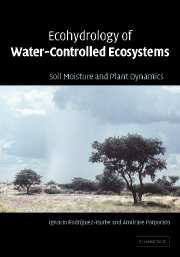Book contents
- Frontmatter
- Contents
- Foreword
- Preface
- 1 Introduction
- 2 Stochastic soil moisture dynamics and water balance
- 3 Crossing properties of soil moisture dynamics
- 4 Plant water stress
- 5 Applications to natural ecosystems
- 6 Coupled dynamics of photosynthesis, transpiration and soil water balance: from hourly to growing-season time scale
- 7 Plant strategies and water use
- 8 Seasonal and interannual fluctuations in soil moisture dynamics
- 9 Spatial scale issues in soil moisture dynamics
- 10 Hydrologic controls on nutrient cycles
- 11 Hydrologic variability and ecosystem structure
- References
- Species Index
- Subject Index
- Plate section
1 - Introduction
Published online by Cambridge University Press: 14 October 2009
- Frontmatter
- Contents
- Foreword
- Preface
- 1 Introduction
- 2 Stochastic soil moisture dynamics and water balance
- 3 Crossing properties of soil moisture dynamics
- 4 Plant water stress
- 5 Applications to natural ecosystems
- 6 Coupled dynamics of photosynthesis, transpiration and soil water balance: from hourly to growing-season time scale
- 7 Plant strategies and water use
- 8 Seasonal and interannual fluctuations in soil moisture dynamics
- 9 Spatial scale issues in soil moisture dynamics
- 10 Hydrologic controls on nutrient cycles
- 11 Hydrologic variability and ecosystem structure
- References
- Species Index
- Subject Index
- Plate section
Summary
Soil moisture and plants are the two main subjects of this book, the former being at the center of the hydrologic cycle and the latter ones representing the primary component of terrestrial ecosystems. The analysis of their interrelationships points at the very heart of ecohydrology, the science that studies the mutual interaction between the hydrologic cycle and the ecosystems (Rodríguez-Iturbe, 2000; Porporato and Rodríguez-Iturbe, 2002).
The interaction between water balance and plants is responsible for some of the fundamental differences among various biomes (e.g., forests, grasslands, savannas) and for the developments of their space–time patterns. The first objective of ecohydrology is thus to understand the intertwined characteristics of climate, soil, and vegetation that make a biome what it is, and to relate hydrologic dynamics to the space–time response of vegetation in a region. Throughout the book, we will concentrate on water-controlled (or water-stressed) ecosystems, where water may be a limiting factor not only because of its scarcity but also because of its intermittent and unpredictable appearance.
Understanding what is the relative importance of the interactions between soil moisture and plants and how this importance changes from one ecosystem to another will be the guide to our modeling effort, which in many ways is inspired by the principle that “the purpose of models is not to fit the data but to sharpen the questions” (Karlin, 1983). We will use simplified analytical models to describe the various mechanisms responsible for the dynamics of soil moisture, from the most basic ones at a point to the more complicated cases involving different spatial and temporal scales.
- Type
- Chapter
- Information
- Ecohydrology of Water-Controlled EcosystemsSoil Moisture and Plant Dynamics, pp. 1 - 14Publisher: Cambridge University PressPrint publication year: 2005



